October 17- 24, 2023

I’m in Love
In my very first social media post after reaching Ljubljana (pronounced Loo-Blee-Ah-Nah) I stated that I was in love. In love with Ljubljana. Not only is Ljubljana the most fun city name to pronounce (ever), but the city simply shines.
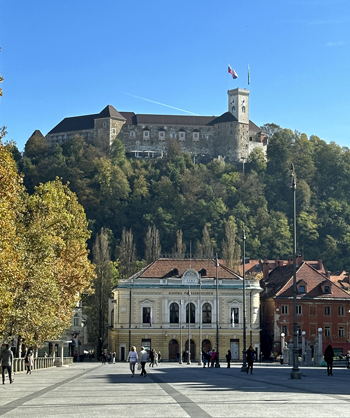
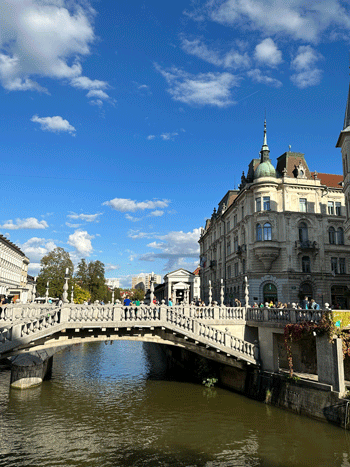



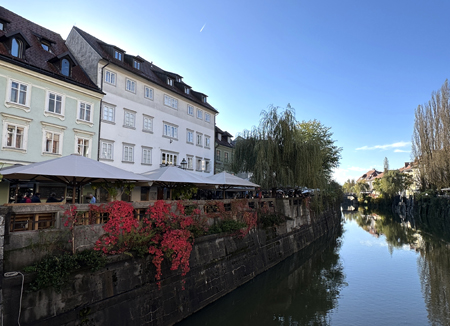
Late October
Yes, the city even shines in late October. Even on a cloudy, rainy day. There’s something very appealing about Ljubljana’s old town center, that’s for sure.
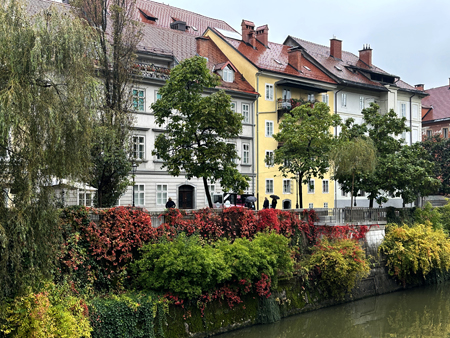
The Ljubljanica river meanders through the heart of the city, and is spanned by many beautiful and architecturally interesting bridges. Everything revolves around the river, adding to the charm of this beautiful city.
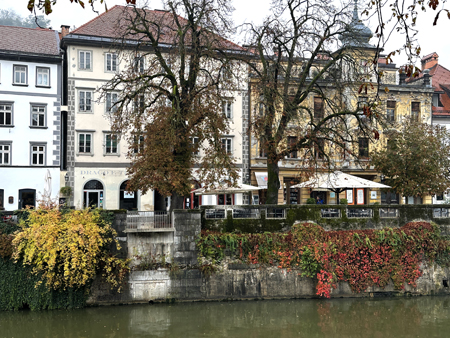

The center is pedestrian only, filled with cobblestone streets, whimsical statues, and Baroque buildings.

The real heart of Ljubljana lies in its Ljubljanica River embankments, densely scattered with lively cafes and bars offering outdoor seating.
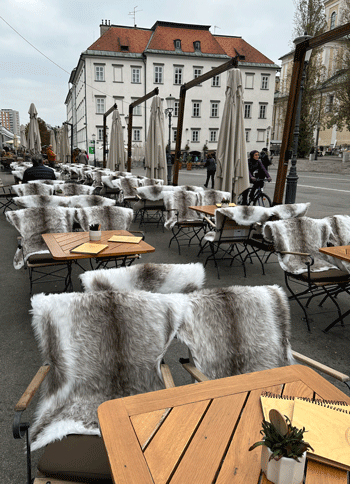
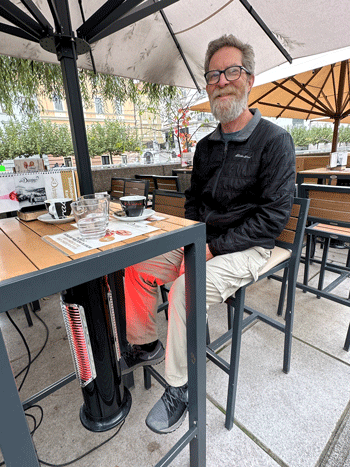
Even in fall’s cooler weather, the cafes offer lots of options to keep the customers toasty warm!
The Austrian Connection
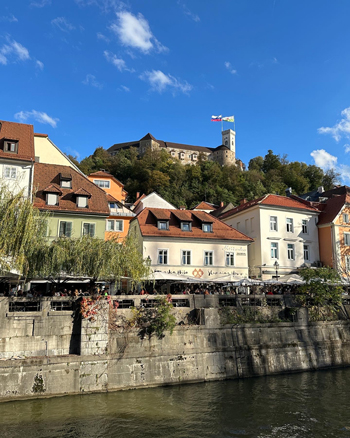

With a charming Old Town clustered around a castle-topped hill, Ljubljana is often likened to Salzburg, Austria. Both towns are also situated on two sides of a beautiful river, near the foothills of the Alps.
The Habsburgs


There’s a darn good reason that Ljubljana is so similar to Saltzburg, Austria. In the mid 1300’s Slovenia came under Habsburgs (of the Austro-Hungarian Empire) rule. The Habsburgs, along with the Holy Roman Empire, ruled the land for the next 600 years.
So even though there have been a good number of different conquerors, rulers, and colonizers through Slovenia’s tumultuous history, the Habsburgs-Austrians had the lion’s share in shaping Ljubljana, the city and culture.
A Bit of Ljubljana History

World War I brought the break with the Habsburg dynasty. In 1918 Slovenia joined the new state, the Kingdom of the Serb, Croats and Slovenians.
Thankfully Ljubljana was spared much of the destruction other cities endured during WWII. After the war, Ljubljana became the capital of Slovenia, one of the six republics of the Socialist Federal Republic of Yugoslavia.
In 1991, Slovenia gained its independence from Yugoslavia, and Ljubljana became the national capital. Slovenia is a member of NATO and part of the European Union.
Surprise Me
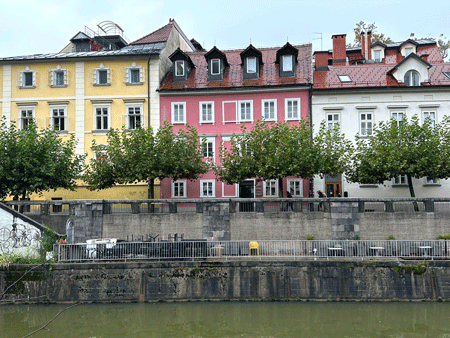
I’ve read that Ljubljana is a foodie’s paradise. I’m a tough customer, being gluten-free and vegan (although I often revert to a vegetarian while traveling). I am happy to report I was pleasantly surprised by Ljubljana.
At home, in progressive Seattle, maybe one out of ten restaurants I visit has a gluten free bun option for a veggie burger, but Ljublajana is a different story. While ordering lunch, I’d hold my breath and ask, with trepidation, “Do you have a gluten-free bun?”
I’d be met with a confident and resounding, “Yes, of course!” Everywhere! Everywhere had a gluten free bun! And it wasn’t a hard, somewhat hockey puck version of a bun either. It was a fluffy, fresh, amazing gluten free bun! Unless you have a food allergy, you cannot know how happy that makes gluten-free me!
Foodie Heaven

Besides the whole gluten-free thing, which I know has its own culture of criticism, Ljubljana does earn its designation as a foodie destination. Although we don’t eat at Michelin star restaurants, we could have. Ljubljana’s culinary scene strongly focuses on seasonal, locally produced ingredients.
Slovenia’s proximity to Italy definitely enters into this equation, with spectacular pizza and Italian dishes served throughout town. Not to mention the gelato and ice cream selections that were off the charts delicious.
City of Dragons


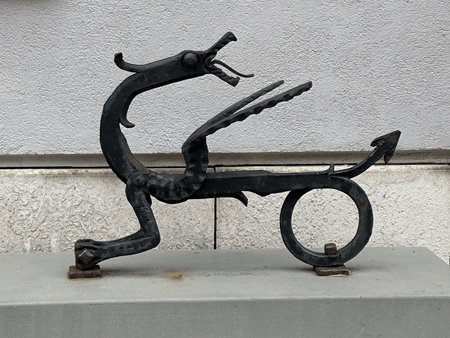
According to legend, Ljubljana’s beginnings are intertwined with Jason and the Argonauts. On returning from a quest for the Golden Fleece, the heroes met a dragon by the lake, which their leader Jason slew. The dragon has since been adopted on the city’s coat of arms.


So, of course, everywhere we walk throughout Ljubljana are dragons. Dragon statues, dragon bridges, and dragon stores. I don’t blame them. Having a dragon as your city mascot is very cool indeed.
Even the street grates are embellished with dragons.
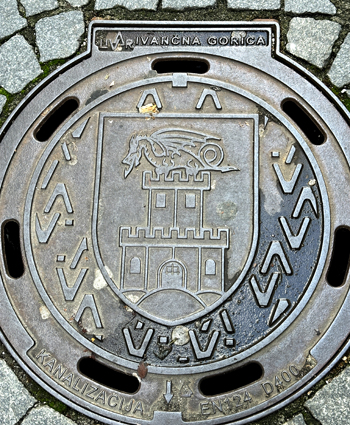
The Green Connection
We were thrilled to learn that Ljubljana has exceptional environmental awareness. Ljubljana won the prestigious title of European Green Capital 2016. The award is a European Commission initiative and is bestowed upon the city that has achieved the highest environmental standards. Ljubljana is committed to environmental protection and sustainable development.
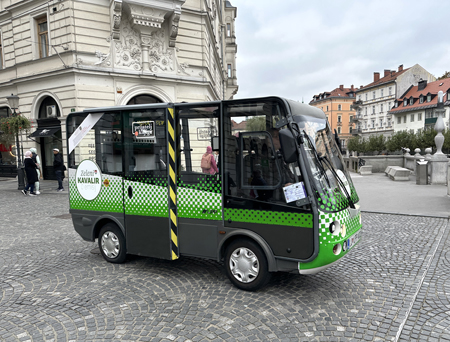
They even have little electric vehicles that roam the old town, free for anyone to hop on/hop off.
Because of Slovenia’s emphasis on preservation of nature, environmental protection, and sustainable growth, it’s considered one of the greenest countries on the planet according to the international organization Green Destinations, and the most sustainable destination in Europe in 2020.
Farmers Market
Even though we were visiting in late October, I was thrilled to see that the huge (mostly organic) farmers market was still in (almost) full-swing! Thankfully we had a full kitchen, so could take advantage of all the fresh fruits & veggies.



Recycling
Ljubljana’s dedication to recycling is admirable. And they make it very convenient for their residents to find recycling – receptacles are all over the city.


Recycling is practically an art form here, with the largest variety of sorting bins than I’ve ever seen- six or more sorting options.


The receptacles are sunken underground, with only the chute showing above ground. It’s an exceptional example of great urban planning.
Bicycle Culture
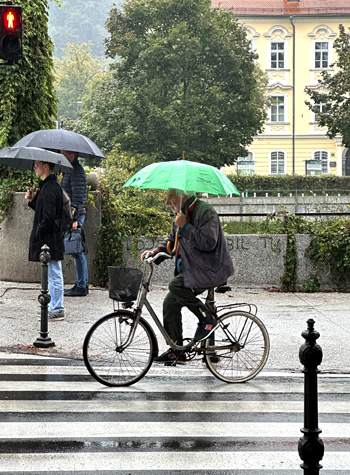
As in many European cities, bicycling is huge. There are bike lanes along the city streets, but mostly, in the old town center which is car-free, the bicycles just weave in and out of the pedestrians with amazing precision.





I saw a moms riding bikes with homemade wooden bucket-like receptacles on the front, full of up to four kids! I wish I’d gotten a picture, but I was so enthralled when they’d pedal by, I guess I didn’t think to grab a pic.



Tivoli Park

Preservation of nature is a huge priority for the city. At one end of town sits the enormous Tivoli park, a green space of over 1200 acres featuring something for everyone. The park is full of chestnut tree-lined paths, a fish pond, a botanical garden, and a variety of statues and fountains. It’s also home to several cafes, an on-site playground and bowling alley, and the Ljubljana Zoo.
The crowning glory of the park is an expansive promenade designed by Jože Plečnik, whose work throughout Ljubljana had a profound and lasting impact on the city.
We visited the park on a wet & very blustery fall day. The crunchy, brown and yellow leaves were falling from the trees, hanging in the air blowing this way and that before they slowly made their way to the ground.
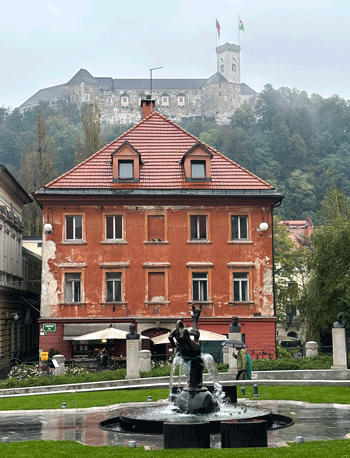
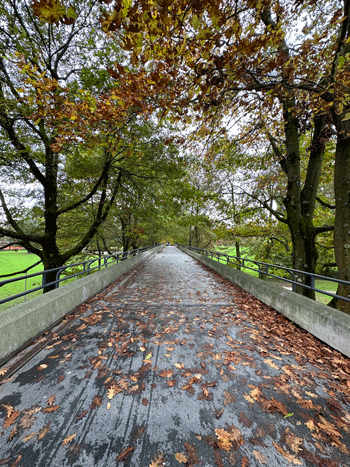

Outdoor Education
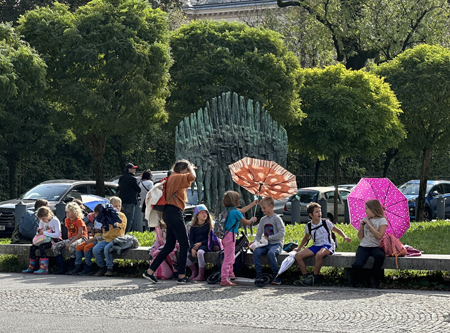
But the wind and rain didn’t keep the school kids indoors. Everywhere we’d travel through the city we saw school groups out and about – from toddlers to teenagers.

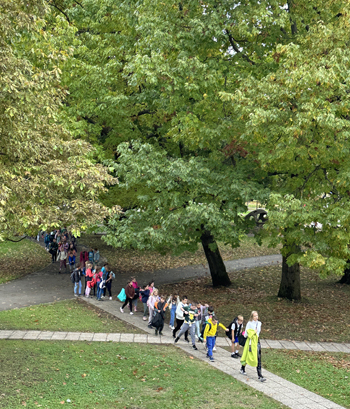

Jože Plečnik, Man of Vision
A big part of the appeal of Ljubljana is due to the vision and works of the architect Jože Plečnik (1872-1957). Plečnik worked in Vienna, Prague, and Ljubljana from the late 19th century all the way until the 1950s. Arguably, he left his greatest mark on Ljubljana.
Jože’s impact on the city cannot be overstated. Plečnik was to Ljulbljana as Mozart was to Salzburg.
Between WWI and WWII, he presented an example of a human centered urban design that successfully changed the very identity of the city following the dissolution of the Austro-Hungarian Empire.

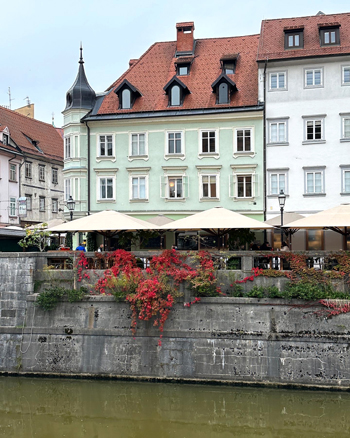

He managed to realize his vision to transform a once sleepy little town within the Habsburg monarchy into the true capital city of Slovenia. Through daring architectural and urban planning projects, he transformed Ljubljana into a comprehensive piece of art.

Plečnik planned and created many public spaces throughout Ljubljana including the riverfront, squares, parks, streets, promenades, bridges, the national library, churches, markets, and a funerary complex. His works were sensitively integrated into the pre-existing urban, natural and cultural context and contributed to the city’s new identity.
Plečnik stood apart from the other predominant modernist principles of his time. It wasn’t until after his death that he was truly appreciated and hailed as a true genius.
Plečnik at Home
We walked across town to tour Plečnik’s home, all the time in a torrential downpour, with no umbrella. We only had fairly flimsy rain shells, that were adept at soaking up every raindrop, leaving us drenched. I’m not sure why I’m smiling in this picture, because I really wasn’t very happy.
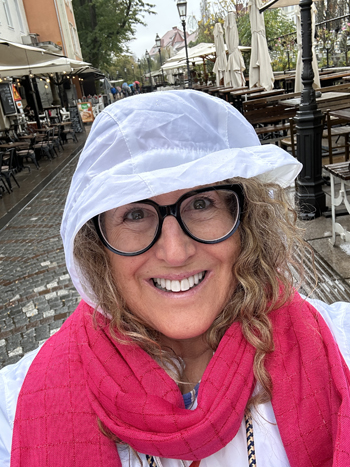
This bad decision was made because it wasn’t raining when we first left the apartment, and neither of us wanted to get stuck carrying the umbrella. Oops. Bad call.
Medieval Gardens

Along our route to Plečnik’s, still in the rain, we passed by large plots of communal gardens amongst residential homes. We later learned that these are protected land. They were, and still are, communal gardens dating back to medieval times. Very cool.
The Cafe
Lucky for us we found a cozy, warm, and dry café just a few buildings away from Plečnik’s place, where we ducked in for a quick coffee before touring his home.
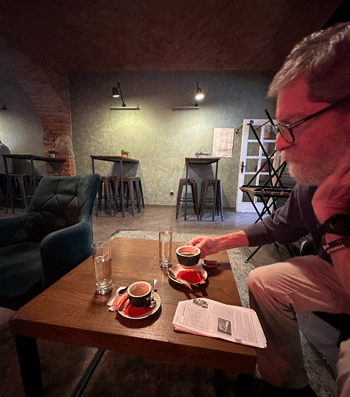
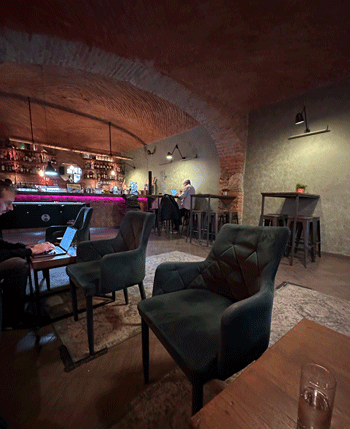
The Tour
A tour is required to visit Plečnik’s home. Learning the story of the artist’s life and the architecture of the house was well worth the time (and wet march across town). The tour guide presented a fascinating story of the artist, as well as the furniture & house that Plečnik designed.
Plečnik’s design style was simple and, above all, functional.
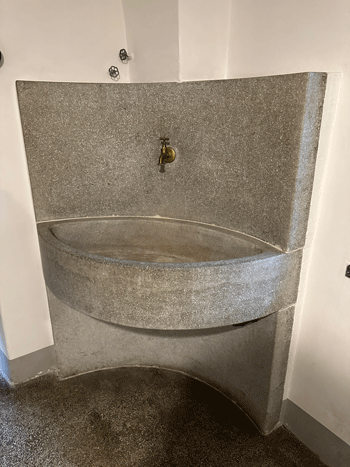
Plečnik, the Man
Plečnik was a very private man, even a bit anti-social.


One of my favorite memories of the tour was seeing the receiving room of in Plečnik’s home, where he greeted guests. The room was stark with a concrete floor and large windows. There was one lone seat in the room, designed by Plečnik. It was a hard wooden bench with a slightly tilted seat (pictured above, left).
The tilt pitched any guest slightly forward, as if encouraging you to be on your way. And with no cushion on the bench, the hard surface wasn’t too welcoming either. The bench was purposefully designed by Plečnik so his guests were uncomfortable, and, in fact, sent a loud and clear, albeit subtle, message not to stay too long. Hilarious!
A Day Trip to Remember

For a fun day-trip we bussed over to beautiful Lake Bled, in the Northwestern part of Slovenia.
The views through the picturesque countryside were so very lovely, even viewed through a bus window. Village after village sat tucked in the green rolling hills; every one of them having a prominent church with a white steeple clocktower.


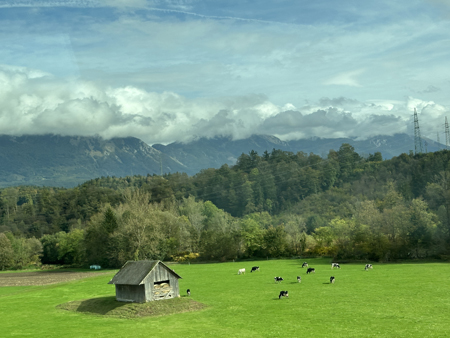
The Lake
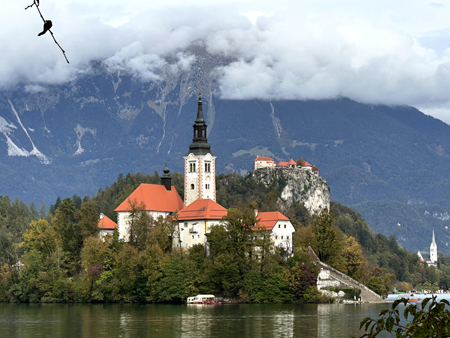
Lake Bled, with the tiny island containing a church (with steeple of course), in the middle, is often the featured image identified with Slovenia. And seeing it in person was just as iconic.
The Julian Alps in the background are the perfect backdrop to the stunning lake and surroundings. When we arrived the clouds were hugging the mountains, but they eventually cleared and we had amazing views of the range on and of through the day.
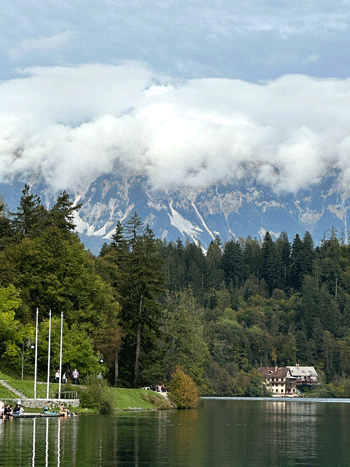

The views just kept getting better and better as we walked the three mile trail around the lake.
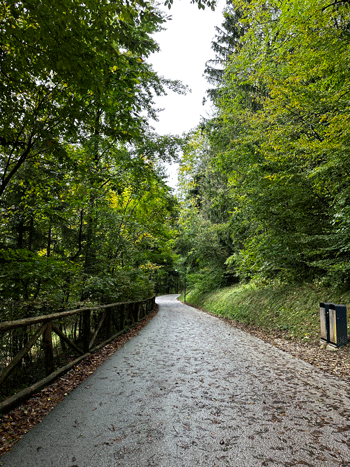
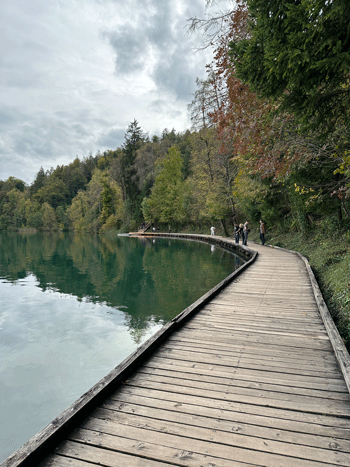
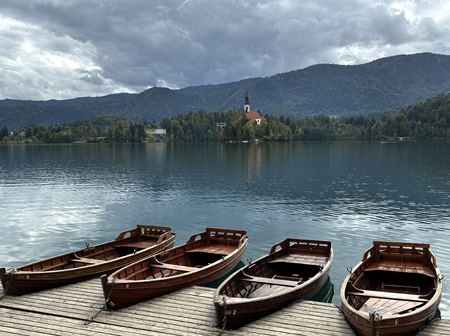
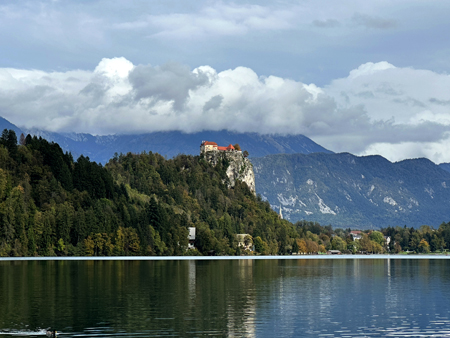
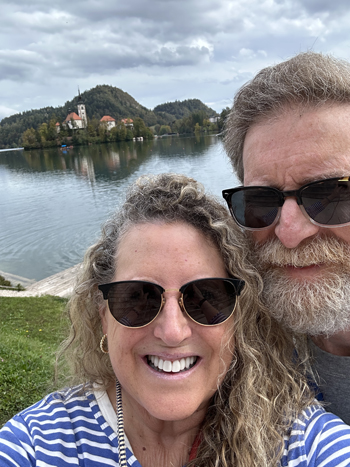

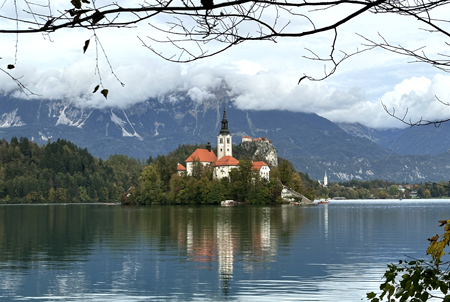
Wins and Losses
Wins
Sts. Cyril and Methodius Orthodox Church: We were lucky enough to happen upon the most unique and stunning church right outside Tivoli Park.



The Ljubljana castle, high up on the hill, provided incredible panoramic views of the Old Town and beyond.
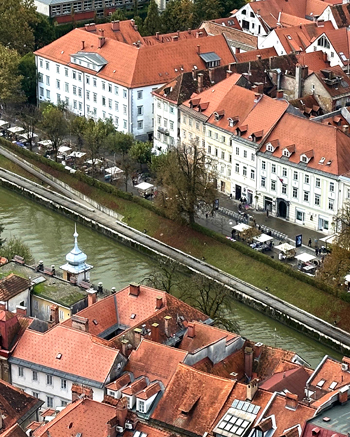




A Marathon! It just so happened that the 27th annual Ljubljana marathon was on our last weekend in town.
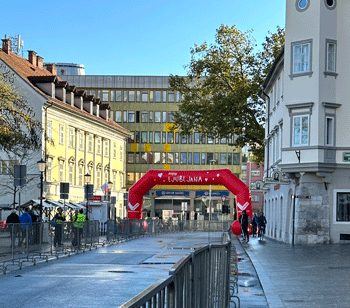
We had no idea it was coming, but it sure was fun. More than 22,500 runners in total came from 68 countries, the largest number in the history of the Ljubljana Marathon. More than 4,500 were foreigners. The town was buzzing and full of fun energy.
Losses
Ljubljana is the last destination of our amazing eight week trip through Istanbul and the Balkans! What an incredible time we’ve had!
Next Up?
Oaxaca, Puerto Vallarta, and San Pancho, Mexico for five weeks starting December 2, 2023.
I LOVE reading these’nn